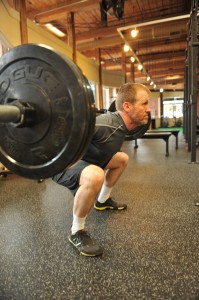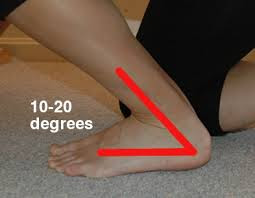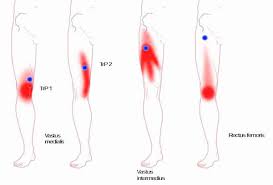“Squats are bad for your knees.”
I don’t know the origin of this foolishness about squats being bad for your knees, but it needs to stop!
I’ve been a personal trainer and strength coach for about 12 years now. Over those years, I think I’ve seen 2 cases where someone shouldn’t actually squat. In both of these cases, they either needed surgery or an artificial knee.
Before I go any further, I need to state that I am not a medical professional. If you have a legitimate medical issue, you should always listen to your doctor and follow his/her advice first and foremost.
 On the other hand, if you do not have a medical issue, but squats haven’t always been friendly to your knees, you may have some technique or movement quality issues. If thats the case, I know I can help.
On the other hand, if you do not have a medical issue, but squats haven’t always been friendly to your knees, you may have some technique or movement quality issues. If thats the case, I know I can help.
At this point I have taught over 1,000 people how to properly squat. Every day I learn something new about movement. By now, I think it’s pretty safe to say that I know what I’m doing when it comes to teaching people how to squat.
I’m not saying squats are harmless or even that squats definitely won’t hurt your knees. For some people, it might be the case. Your knees might hurt.
BUT…simply stating “squats are bad for your knees” is pretty ridiculous. Blanket statements are generally filled with opinion and exaggeration, but they’re rarely 100% factual.
Let’s look at this example.
Are peanuts bad for you?
Maybe.
If you are allergic to peanuts, then yes, they are bad for you.
If you are not allergic, a small handful of peanuts is a great source of healthy fat.
So the answer to the question “Are squats bad for your knees?” should be, “It depends.”
So, why do squats have such a bad reputation as being bad for your knees when the real answer is, “it depends”?
Here are the most common scenarios I have seen over the last 12 years in people who claim squats hurt their knees.
Poor Technique
To be honest, when most people first come to my gym they do not squat correctly. Some come pretty close, but we always tweak a few things to allow each person to squat more comfortably.
 Everybody squats differently. A 6’5” rower and a 5 ‘2’ softball player will have squats that look very different. Both athletes are capable of squatting, but their technique will vary immensely.
Everybody squats differently. A 6’5” rower and a 5 ‘2’ softball player will have squats that look very different. Both athletes are capable of squatting, but their technique will vary immensely.
The two biggest culprits I see when it comes to poor technique are valgus collapse, (pictured here) and when the squatter shifts too much weight into his/her toes causing the heels to rise. These common technique issues can normally be cleaned up with some quality coaching. If you work with a good coach, he or she should be able to teach you how to squat safely and effectively in a relatively short time frame.
The key is to start with quality, then add quantity! In other words, get the movement right before adding weight and volume.
Restricted Ankles
If you have decreased ankle mobility, specifically dorsiflexion, you will have a tough time squatting. If your ankles are jammed up, it will be very tough to keep a vertical torso in the squat. If you’ve ever worn ski boots, you’ve experienced a similar sensation. The boots basically lock your ankles in one position. When your ankles are locked, the majority of your weight is shifted posteriorly.
 If you have decreased ankle mobility, your squat will likely look more like a hip hinge or a good morning. This can make it tough to squat below parallel with a neutral and might also cause your heels to elevate as you descend.
If you have decreased ankle mobility, your squat will likely look more like a hip hinge or a good morning. This can make it tough to squat below parallel with a neutral and might also cause your heels to elevate as you descend.
If you choose to squat this way (low bar position) that’s a different conversation. I’d rather see you squat a certain way due to preference rather than squatting a certain way due to lack of options.
Most coaches would probably agree that having appropriate ankle dorsiflexion is vital to athletic performance. In a perfect world, I would love to see everyone have 20 degrees of ankle dorsiflexion.
Trigger points/poor tissue quality
 Trigger points are small, hyper -sensitive areas of contracted muscle fibers. They can be found anywhere in the body, but when it comes to knee sensitivity, looking above the joint is a good place to start. Trigger points often wreak havoc on the joints they are closest to. If you have trigger points in any part of your quad, they could refer pain into your knee.
Trigger points are small, hyper -sensitive areas of contracted muscle fibers. They can be found anywhere in the body, but when it comes to knee sensitivity, looking above the joint is a good place to start. Trigger points often wreak havoc on the joints they are closest to. If you have trigger points in any part of your quad, they could refer pain into your knee.
There are a couple of ways you can address trigger points:
1. Find a reputable massage therapist and hire him/her. A good therapist is worth the investment.
 2. Purchase a foam roller and spend some time getting comfortable with it. I ‘m a huge fan of THE GRID foam rollers. They last forever and do an excellent job.
2. Purchase a foam roller and spend some time getting comfortable with it. I ‘m a huge fan of THE GRID foam rollers. They last forever and do an excellent job.
When you foam roll, it’s important to start with light pressure that will not create pain, force you to tense up, or alter your breathing patterns. I suggest spending 1-2 minutes on your “hot spots” and progress from there.
Threat Response
 Your nervous system doesn’t care if you are squatting, lifting groceries, picking up your child or prancercising. (Okay, it does care if you prancercise, don’t do that. Ever.)
Your nervous system doesn’t care if you are squatting, lifting groceries, picking up your child or prancercising. (Okay, it does care if you prancercise, don’t do that. Ever.)
Your CNS will act accordingly based off of how it perceives the scenario. If it brain senses threat, a few things will happen. Your heart rate will elevate, your breathing will change and/or your body may stiffen up, create pain or give you some other warning sign that basically says “hey, I don’t like that at all.”
Squats shouldn’t be scary but if your body perceives squatting as a threat then you need to hire a good coach that can regress the exercise so you can learn it in a safe and effective fashion.
Think of it this way, if your cars brakes are always on, there’s no way you can drive it correctly.
If squats hurt your knees, find a good coach and see if you have some technique or movement flaws you can clean up to start squatting properly!
Already squatting with proper technique and with no pain?
In a recent YouTube video on our page, our Head Strength and Conditioning Coach, Steve, goes over 3 Squat Tips for improving your barbell squats.
